If Greve in Chianti is the commercial brain of Chianti, Radda is its soul. With its small-town mood, picturesque Radda makes an appealing base for exploring wine country. Given its prime position between Gaiole and Castellina, Radda served as the capital of Chianti, and was the medieval capital of the Chianti League. The fortifications reflect Radda’s history as a borderlands and bulwark against Sienese attacks. Peace finally came to this area after Siena was incorporated into the Republic of Florence in 1559. Hilltop Radda retains its medieval street plan and imposing town hall. Formerly known as the Palazzo del Podesta, the 16th-century town hall displays heraldic shields on its façade. Radda is still bound by its defensive walls, with cobblestoned alleys fanning out from the main square. Today’s mellow scene is centred on the Casa Chianti Classico, a showcase for everything wine-related so come here to make sense of the Chianti spirit.
Radda in Chianti
-
-
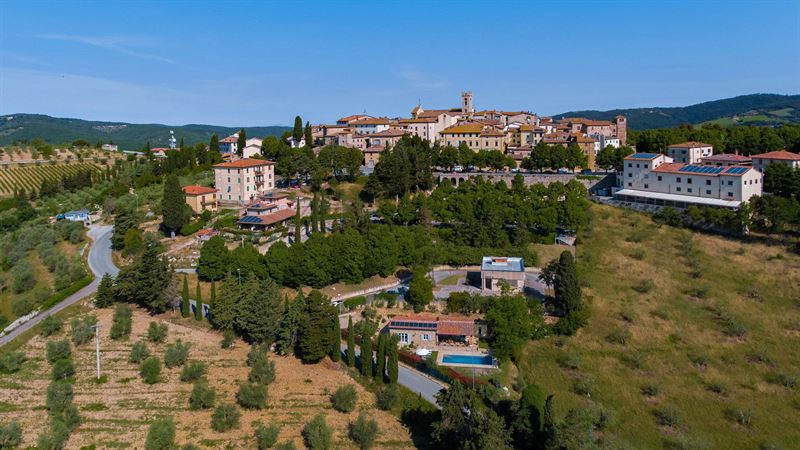
Top Ten Things to Do
Radda makes a great base for activities as varied as visiting a Chianti cashmere goat farm or taking in a centre for contemporary art. As well as drinking up wine estates, you could visit a wine museum or try a wine appreciation class. Or perhaps cycle to a vineyard. Even if Radda itself is a key attraction on the Chiantigiana, the Chianti Way also leads to forays to neighbouring Chianti wine hamlets, such as atmospheric Volpaia. As for culture, consider day trips to San Gimignano, Siena and Florence.
This is just a taster to the Chianti. See our specific guides to top Chianti outposts, all accessed through our Destinations listings. -
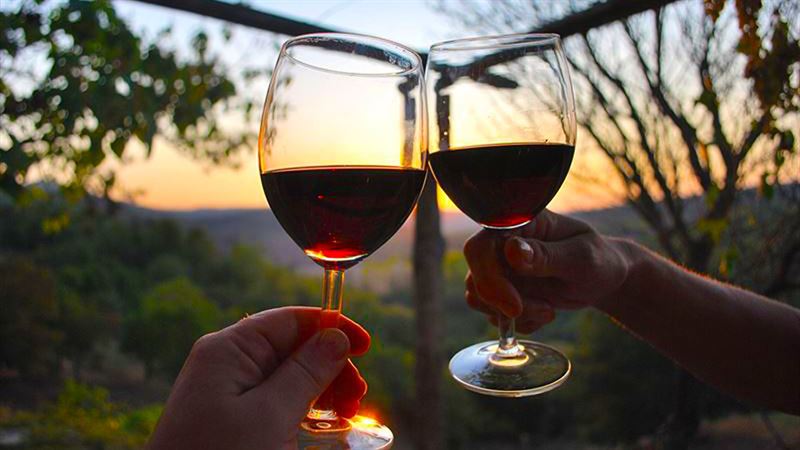
1. Wine class, tasting and lunch in Casa Chianti Classico
Casa Chianti Classico, an exceptional concentration of wine expertise, is housed in an 18th-century Franciscan monastery in the upper part of town. Itself attached to a medieval church, this sacred complex is now a shrine to wine, with a Wine Museum on the first floor. Sign up to a 90-minute wine class or restrict yourself to learning all about Chianti before facing an entertaining multimedia wine quiz. After doing a wine-tasting and dutifully going through your tasting notes, you deserve lunch in the Enoteca. Even better, it features a charming terrace surveying the Chianti vineyards.
As a major wine centre, Radda has been quietly prosperous since the 16th century when it was already exporting wine to England. Later, in 1716, Cosimo III, Grand Duke of Tuscany, officially delimited the production zone of Chianti wine. Along with Radda, the main centres in Chianti Classico remain Greve, Panzano, Castellina, Gaiole and Fonterutoli. The boundaries and strict rules still apply, even if the responsibility for enforcing them has passed to the Chianti Wine Consortium. The Consortium was established in 1927 by a group of wine producers in the Provinces of Florence, Siena, Arezzo and Pistoia. Easily accessible off the scenic route SS222, the grandest, castle-like estates have often been run by the same families since medieval times, as is the case with the aristocratic Antinori, Frescobaldi, Mazzei and Ricasoli dynasties. Tuscany’s aristocrats are still over-represented in the wine business, including in the Chianti Classico Wine Consortium. On the board are a clutch of Tuscan nobles, ancient wine dynasties who have moved with the times. The great names include Marquess Lodovico Antinori, Count Lorenzo Guicciardini, Prince Emmanuele Corsini and Count Guido Chigi-Saracini.
Address: Museo del Vino
Monastero Santa Maria al Prato
Circonvallazione Santa Maria al Prato 18
53017
Radda in Chianti
Tel: 0577 738187
Web: https://www.casachianticlassico.it/it/ -
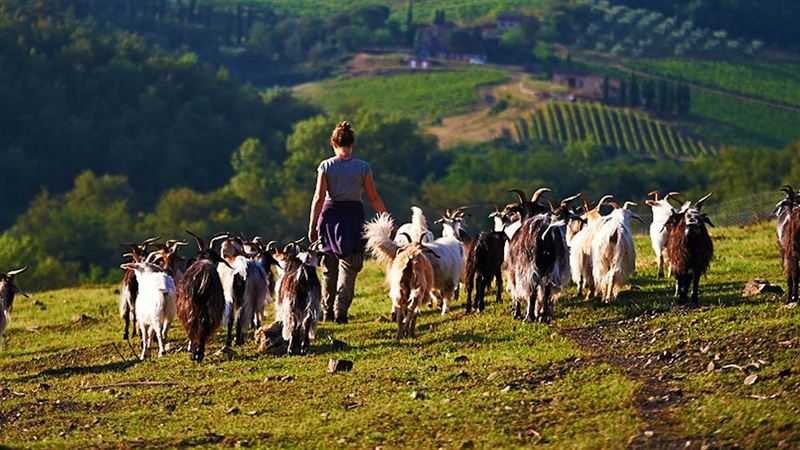
2. Chianti Cashmere Goat Farm
If you’ve got young children in tow or are simply tired of wine estates, then visit the quirky Chianti Cashmere Goat Farm, just north-east of Radda. Run by American-born Nora Kravis, this long-established cashmere farm goes from strength to strength. It’s fun but also represents sustainable farming at its best. Founder Nora Kravis left New York’s Long Island for Italy long ago and never looked back. She knows all the shepherds, herders, growers and weavers and cares for her goats as if they were family. At this stone farmhouse with a view, the kids can hold, pet and bottle-feed the kid goats. The goats are guarded by fluffy white Abruzzo shepherd dogs who act as guard dogs to keep any wolf pack at bay.
After getting your fill of cute goats and puppies, turn your attention to the cashmere itself. In colour, the superior cashmere goats are shades of cream, hazelnut, brown, grey and charcoal so the yarn can be used undyed in its original shade. Cashmere is the fine, fluffy, downy undercoat produced by a cashmere goat and is apparently ten times lighter and warmer than wool. Knitters can choose some lovely fibres and sustainable cashmere yarn. You can also buy home textiles hand-made in Tuscany as well as hand-woven, scarves, shawls, throws, hats, socks and baby blankets.
If you’re won over, the farm can organize spinning, weaving, knitting or embroidery classes with local Italian artisans who already work with them. Best of all, there’s the new `be a shepherd for the day’ experience. This is fun for all the family, with full-immersion in the life of a cashmere goat shepherd. Guests get to accompany a herd of goats through the fields and woods surrounding the farm, stopping for a wine-tasting at a neighbouring farm, and coming back to the cashmere farm for a lavish farm lunch. The farm and gift shop are open in the afternoon from Easter to October.
Address: Chianti Cashmere
Azienda Agricola La Penisola
La Penisola
53017
Radda in Chianti
Web: www.chianticashmere.com -
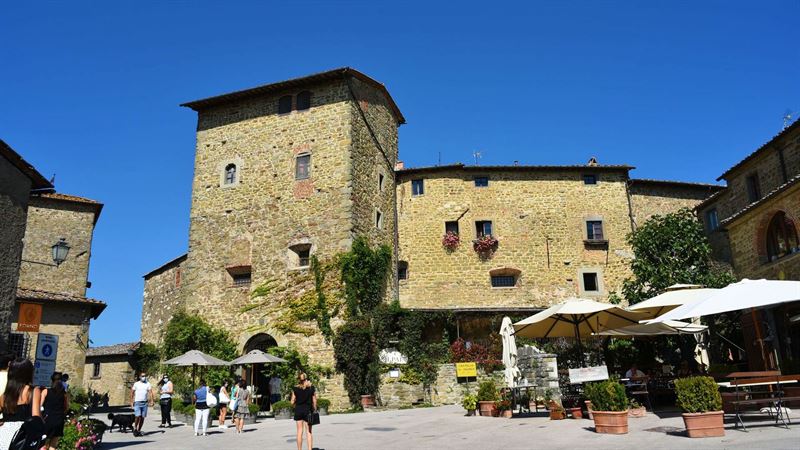
3. Visit Volpaia, a quaint hilltop village
Volpaia, an enchanting medieval hamlet just north of Radda, is reached along a scenic winding road. Framed by walls and towers, this fortified hamlet has retained its medieval layout and defensive character. Book an unusual wine-tasting and cellar tour in the Castello di Volpaia estate in the heart of the hamlet. The cellars start from a sacristy and end up in yet more cellars hidden below churches. In Volpaia, once sacred spaces are now given over to wine-making. It’s a mysterious process. The wine is moved by means of a maze of interconnected stainless steel pipes. Even to reach the tasting room involves traipsing along narrow corridors and ancient staircases. The crypt of the Renaissance-era Commenda di Sant’Eufrosino church is now used to store barrels of the estate’s ageing wine.
For more on this fascinating fortified village, including dining options, see our Volpaia guide.
-
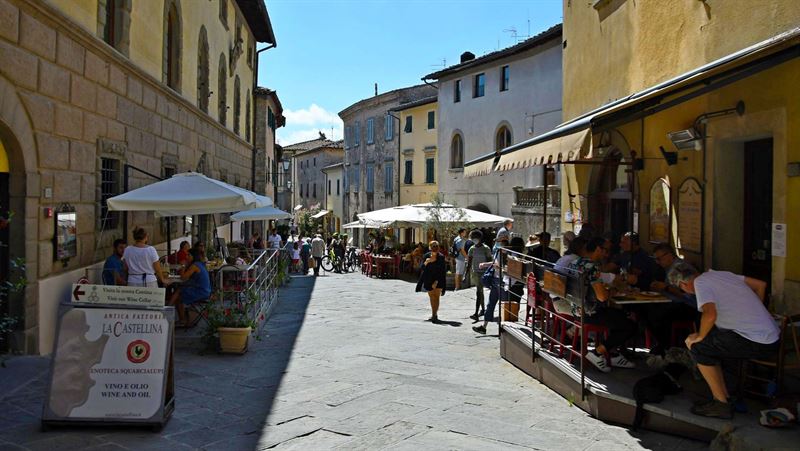
4. Castellina in Chianti for a foodie foray
Visit neighbouring Castellina in Chianti, a charming town just west of Radda. Wander down via delle Volte, a quaint stone-vaulted street built into the side of the hill. Devour delicious ice cream at Gelateria Castellina, known for its experimental ices. The flavours range from ricotta and fig to chilli and chocolate or lemon and kiwi fruit. There’s also the owner’s favourite creation, cantuccini and Vin Santo: almond biscuits with sweet Tuscan wine. There’s no escaping wine in the Chianti.
For more information, see our guide to Castellina in Chianti.
-
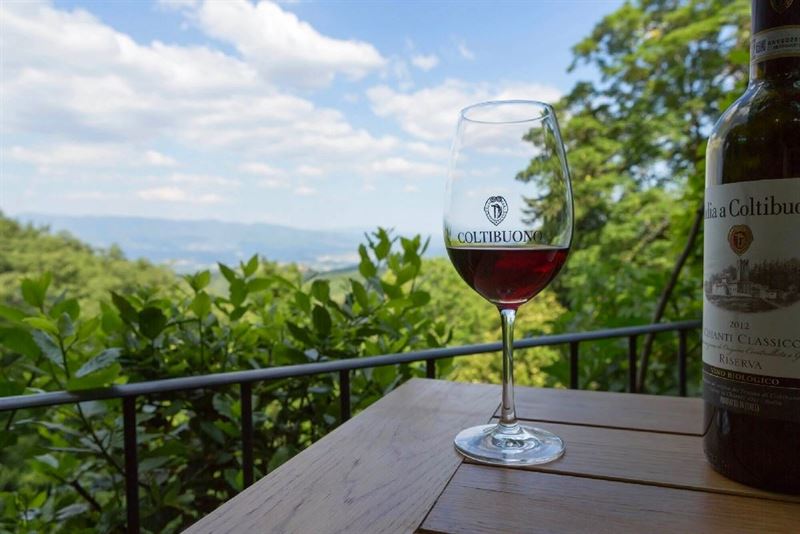
5. Badia a Coltibuono – dreamy abbey wine and oil estate
Set just north of Radda and Gaiole, this former Benedictine abbey surveys gorgeous estate vineyards. The tranquil oil and wine estate commands landscape that has been cultivated since time immemorial. In Tuscany it is hard to separate the wine and oil from the scenery. The aptly named Badia a Coltibuono (Abbey of the Good Harvest) is framed by pines, oaks, chestnuts and vines. Founded in 1051, the medieval abbey belonged to reformist Vallambrosan monks who established viticulture here. Little did they know that their estates would still be flourishing so many centuries later. Since the Dissolution of the Monasteries in 1810, this medieval abbey has belonged to one family. The forward-looking Stucchi Prinetti family started off as Florentine bankers before pioneering the commercialisation of quality Chianti here. The family remains committed to sustainable farming.
The beguiling 15th-century cloisters, chapel and frescoed ceilings can be viewed as a guest of the Tuscan cookery school, while the 12th-century walls and bell-tower are open to all. You can also book a tour of the original monastic cellars and frescoed villa, followed by a wine-tasting. Below the former abbey are cellars filled with Chianti Classico, the abbey’s traditional living. No less famous are the aromatic chestnut honey and olive oil, the delicious Extravergine Badia a Coltibuono. Much of the produce can be bought on the premises or savoured in Ristorante Chianti, the excellent abbey restaurant. You can also do a cookery course run by Benedetta Vitali, founder of the noted Florentine restaurant Cibreo. within the former Romanesque abbey.
Address: Localita Badia a Coltibuono
53013
Gaiole in Chianti
Tel: 0577 74481
Web: www.coltibuono.com -
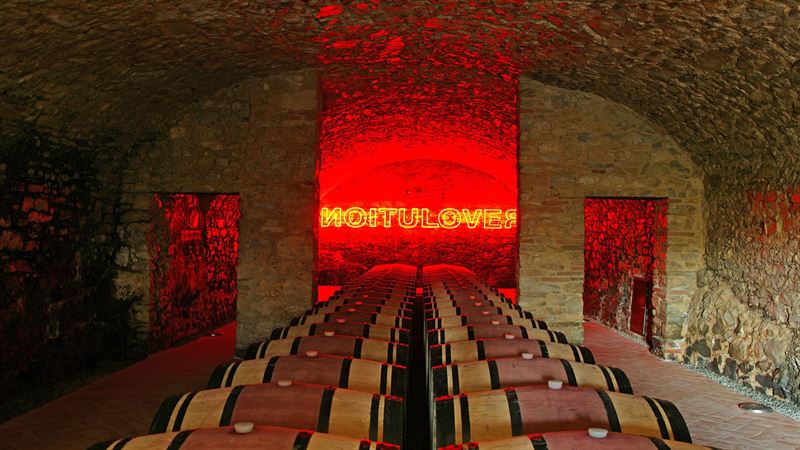
6. Castello di Ama for contemporary art
As one of the leading Chianti Classico producers, this working wine estate just south of Radda is known for its superb, full-bodied reds. Castello di Ama is not even a castle but a hilltop wine estate and villa restaurant, doubling as a centre of contemporary art. At first sight it’s yet another traditional borgo, a stone-built hamlet nestling in the Chianti hills. Slowly, it becomes clear that wine, food and contemporary art are all part of the picture. This was the wine estate that entranced the Obamas on their post-presidential tour of Tuscany.
The wine is master-minded by Tuscan Marco Pallanti, regularly crowned wine-maker of the year, with wines often in the world’s top ten lists. The estate’s San Lorenzo is a Chianti Classico gran selezione DOCG, a category considered the finest expression of its kind. The 80 hectares of vineyards cover different terroirs, from rocky schist to clay and gravel, with another 40 hectares given over to olive groves. The olives end up in the estate’s extra-virgin DOP Chianti Classico olive oil.
The grounds are home to a world-class collection of contemporary art installations. This ambitious collection, Castello di Ama per l’Arte Contemporanea (Castello di Ama for Contemporary Art)
The sculptures respond to the setting, much as the wines do, and are being added to each year. Castello di Ama repurposes original buildings, such as an on-site church and wine cellar, to showcase art installations in a striking way. The art is hard-core contemporary rather than soothingly pastoral.
The site-specific contemporary art is commissioned from artists of the calibre of Anish Kapoor, Daniel Buren, Louise Bourgeois, Michelangelo Pistoletto, Hiroshi Sugimoto and Lee Ufan. The most engaging and accessible is the show-stopping mirrored installation by Daniel Buren that reflects the rolling hills. A Louise Bourgeois sculpture entitled Topiary is ingeniously hidden beneath a grate in the wine cellar floor and depicts a female form flowering into a male phallus. Aima, a thought-provoking Anish Kapoor light installation, illuminates the estate’s tiny chapel.
Book a wine tour and tasting, come for lunch, visit the sculpture park, or simply visit the estate’s Enoteca to sample and buy the wines, olive oil and nature-inspired home fragrances.
Address: Castello di Ama
Localita Ama
53013
Gaiole in Chianti
Tel: 0577 746069
Web: www.castellodiama.com -
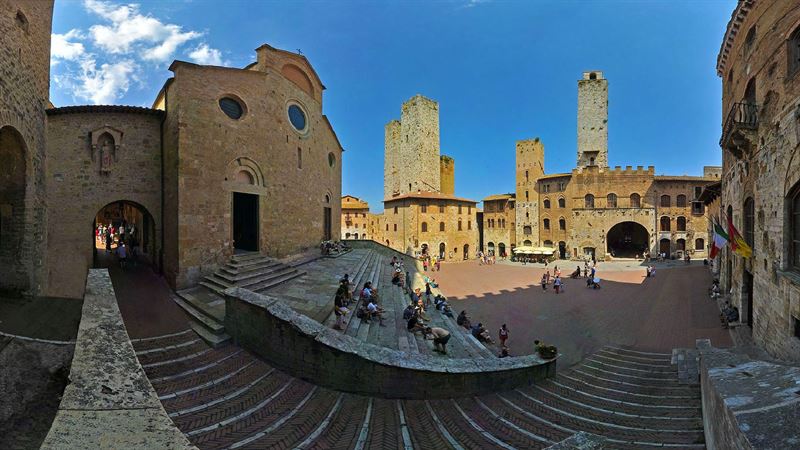
7. San Gimignano – medieval Manhattan
San Gimignano is only 43 km west of Radda so makes a worthwhile trip to see one of the medieval wonders of Tuscany. Given its spectacular setting, San Gimignano is one of the most touristy towns in Tuscany but manages to rise above the masses. With its moody medieval towers and walls, San Gimignano is one of the symbols of Tuscany. Building a lofty tower-house represented one-upmanship, medieval-style. The tower-studded skyline is one of the most spectacular sights in Tuscany. In its heyday, the city had a total of 72 towers, only 14 of which remain. Tower-houses were castle-residences serving as both warehouses and fortresses. A plague in 1348 wiped out much of the local population and the town slumbered as a backwater for centuries. The result is a medieval time capsule, even if the town is far from slumbering today. Its over-popularity and sometimes inflated prices are the only downsides but shouldn’t deter you from joining the throng.
See our full San Gimignano guide for more.
-
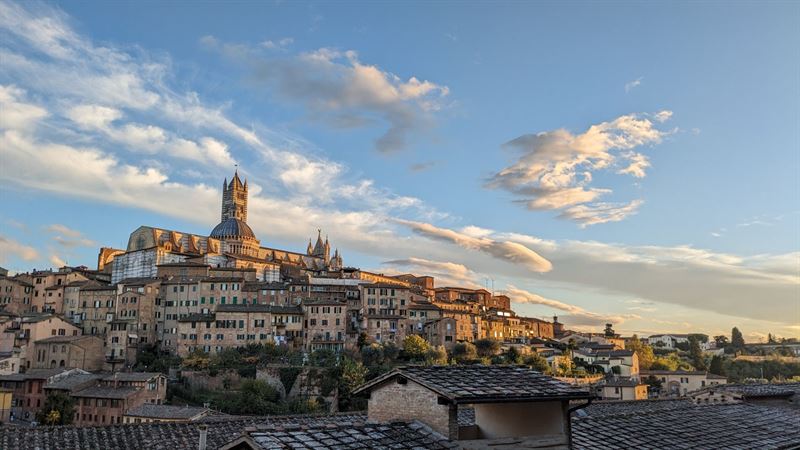
8. A day trip to Siena
Siena is a forty-five-minute drive from Radda and makes a magical day trip. Siena frames the southern end of the Chianti and so is convenient for anyone based in Radda. As a Gothic city built on a human scale, Siena is effortlessly civilised and at ease with itself. All roads lead to Il Campo, the beguiling, shell-like central square, shaped like an amphitheatre. Sit at a terraced café on the sloping side of the square and spot the division of the paved surface into nine segments, recording the wise Council of Nine who governed Siena from the mid-13th century to the early 14th. Consider climbing the slender Torre del Mangia, with sultry views over a pink piazza and Siena’s rooftops, even if the views from the Cathedral rooftops are even better.
Check our Siena guide to see what appeals most.
-
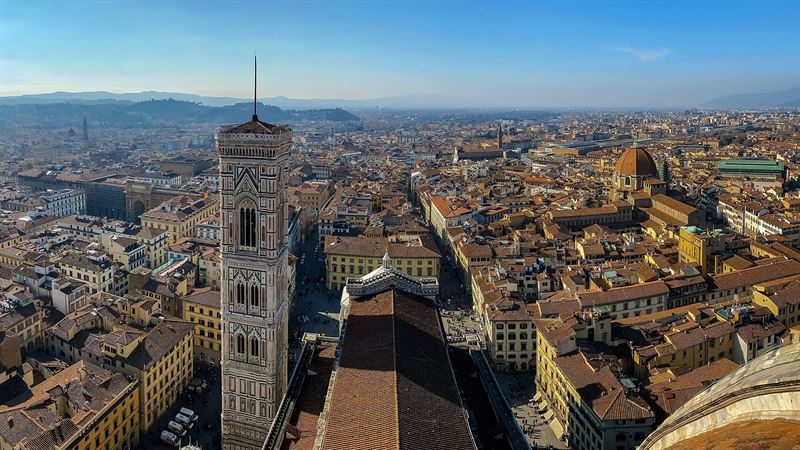
9. Art-filled Florence
Although over an hour’s drive from Radda, Florence still makes a perfect day trip. Despite devouring the checklist of must-see sights, steer clear of suffocating under the weight of treasures. Allow time for aimless wandering. Beyond the selfie sticks and statuary awaits a funky foodie haunt with sleek cafes, superb cooking and seriously edible markets. Florence is not fusty. Nor has the greedy city lost its gutsy Tuscan soul: traditional inns still serve earthy peasant fare, including macho steaks. Beware of trying to do too much on a day trip. Balance visits to galleries with wanderings in search of the perfect trattoria or the perfect view.
Check our Florence guide to see what appeals most.
If visiting a number of museums, consider buying a Firenze Card online
Web: www.firenzecard.it -
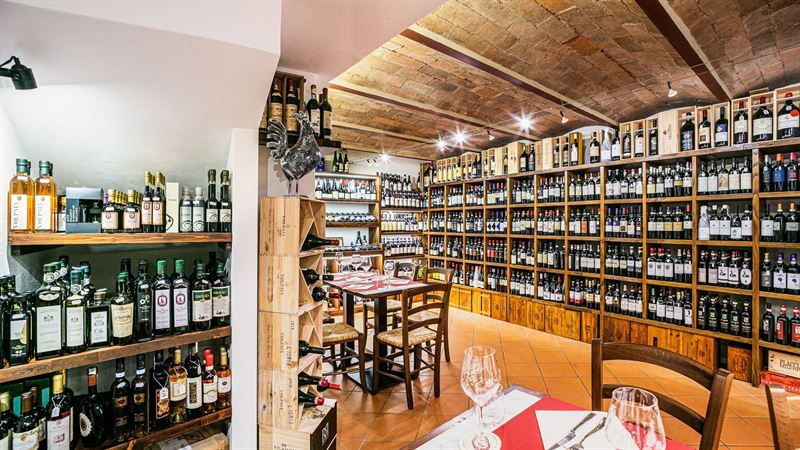
Eating & Drinking
Radda is wine central. It was just over 300 years ago that the boundaries of the Chianti wine region were set. These borders largely correspond to the current Chianti Classico zone. Radda is still awash with Chianti Classico but it’s not the only wine in town. Meals often end with a tasting of sweet Vin Santo. Trebbiani and Malvasia grapes also hang up to dry for Vin Santo, made in Chianti and other parts of Tuscany. The wine is fermented and aged for up to six years in small barrels, known as orcaratelli. This strong dessert wine is comparable to a good medium sherry. Our recommended wine estates are featured in each of the individual Chianti guides.
This area has everything to offer the foodie, with dishes designed to bring out the richness of the wine. From the macho T-bone steaks to peasant soups, wild boar stews, truffle sauces, hearty cheeses and divine cakes, this is as far removed from faddish cuisine as you can get.
This is just a taster to the Chianti. Check our restaurant recommendations below and also see our other guides to top Chianti towns and villages, all accessed through our Destinations listings. -
La Casa Porciatti
Tucked into an early 14th-century building in the heart of Radda is this homely wine bar. It also doubles as a good-value inn and wine shop. Along with a wide selection of Tuscan wines, you can tuck into taglieri, platters of home-cured meats or cheeses, along with porchetta (roast suckling pig). For something more substantial, choose stubby pici pasta with a meaty ragù sauce, ravioli with black truffle or hearty ribollita soup. Florentine tripe, wild boar stew and Sienese ossobuco are also on the menu.
Address: Medieval Walkway - Via Roma 51 - 53017 Radda in Chianti, Siena - Tuscany
Tel: www.casaporciatti.it
Web: +39 0577 738234 -
La Bottega
Set in Volpaia, an enchanting medieval hamlet just north of Radda, this delightful family-run inn serves special but unfussy Tuscan dishes. These are complemented by sound Chianti Classico wines, along with salads and vegetables from the kitchen garden. Mid-priced dishes include hand-rolled pasta or ribollita soup followed by wild boar or Florentine T-bone steak. To be sure of grabbing a table on the shady terrace, book ahead and enjoy the views from the hilltop hamlet over the timeless countryside below. For other dining options in the hamlet, see our Volpaia guide.
Address: Piazza della Torre 1
Volpaia,
53017
Radda in Chianti
Tel: 0577 738001
Web: www.labottegadivolpaia.it -
L’Osteria Le Panzanelle
Set on the road between Radda and Panzano, this is a bastion of Tuscan home-cooking. With its white-washed walls, it’s an unpretentious but utterly reliable country trattoria. Come for the home cooking, friendly service, short but seasonal menu and the extensive Tuscan wine list. Tuck into the roast rabbit, the pumpkin ravioli or any pasta in wild boar sauce. End with the panna cotta or the homemade, crunchy cantuccini biscuits, ideally dipped in Vin Santo.
Address: Loc. Lucarelli, 29
53017 Radda in Chianti SI
Tel: 0577 733511
Web: www.lepanzanelle.it -
Il Ristorante Chianti
This popular stop on the Chianti trail lies along scenic roads 9 km east of Radda. The rural restaurant is set on the glorious wine and olive oil estate of Badia a Coltibuono, complete with its 11th-century abbey. Housed in the former stables, the inn makes use of a charming terrace in summer. Dine under a rose-trailing pergola and tuck into largely organic produce, including from the estate. Modern Tuscan dishes include cured meats, organic pasta with wild duck sauce, fennel soup, lamb or rabbit mains, and home-made fruit tarts or chestnut pastries. The impressive seasonal tasting menu is under 60€, complete with a wine pairing of four wines. The estate wine, oil and chestnut honey are also on sale.
Address: Badia a Coltibuono,
Localita Badia a Coltibuono,
53013
Gaiole in Chianti
Tel: 0577 749031
Web: www.ristorante.coltibuono.com -
L’Osteria del Castello
Set south of Radda, this convivial inn lies in Castello di Brolio, the ancestral castle estate of the Ricasoli wine dynasty. Combine a tour of the castle with lunch in the estate inn. Alternatively, the sunset tour of the castle includes dinner in the Ricasoli’s restaurant. Your castle ticket also allows for a free wine-tasting in the Ricasoli tasting rooms below the castle. With lunch, indulge in the Barone Ricasoli Castello di Brolio Chianti Classico 2006. Dishes are creative twists on traditional Tuscan cuisine. Along with classic Florentine-influenced meat dishes, expect more fish than found in most of the Chianti. Such dishes as olive gnocchi in pecorino sauce or rabbit salad with crispy spelt can also be paired with Ricasoli wines.
Address: Castello di Brolio
Localita Madonna a Brolio
53013
Gaiole di Chianti
Tel: +39 0577 730 290
Web: https://www.ricasoli.com/osteria/ -
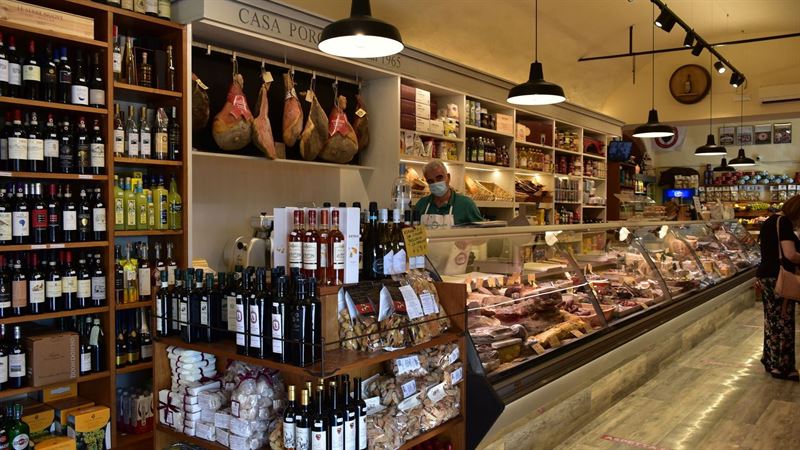
Shopping
Browsing for ceramics or cashmere in Radda makes a change from wine-shopping. Even so, on the wine front, do call into L’Accademia del Buon Gusto in Panzano in Chianti for one of the most entertaining wine-tastings in Tuscany. Then turn your thoughts to ceramics. Tuscan ceramics made in the area are often inspired by ancient models, including Renaissance designs. The Medici dynasty had sets of dishes designed for each of their country villas, virtually inventing the concept of elegant place setting.
-
Le Ceramiche Rampini
Rampini Ceramics specialise in hand-decorated and often historically-inspired ceramics from Tuscany, Umbria and beyond, along with original new designs. This talented international team of artists and craftspeople are based in an old Tuscan farmhouse in Vistarenni, just east of Radda. Their charming studios and showroom offers an overview of Tuscan ceramics. Rampini reproduce Renaissance designs and exuberant decorations based on allegories, animals, flowers, fruit and foliage. Buy a single piece or a full dinner service, with shipment sorted.
Address: Le Ceramiche Rampini
Casa Beretone di Vistarenni
53017
Radda in Chianti
Tel: 0577 738043
Web: www.rampiniceramics.com -
La Ceramica di Angela Pianigiani
Expect brightly-coloured floral motifs decorating hand-painted plates and vases. These are reasonably priced one-off designs, including commissions. The artist’s workshop is just south of Radda.
Address: Localita Malpensata
53017
Radda
Tel: 0577 738466 -
Chianti Cashmere Goat Farm
Consider visiting the Chianti Cashmere Goat Farm to see a delightful herd of cashmere goats. Or make it a proper outing. After petting or feeding the kid goats, browse for hand-woven Tuscan cashmere scarves, shawls, throws, hats, socks and baby blankets.
Address: Chianti Cashmere
Azienda Agricola La Penisola
La Penisola,
53017
Radda in Chianti
Tel: 0577 738080
Web: www.chianticashmere.com -
Luxury designer outlets
For a complete change of scene, designer shopping fans could head to the luxury outlets in the Valdarno area. The Mall Firenze is a thirty-minute drive east from Florence, on the Pontassieve road. There’s also a direct shuttle bus there from Siena. After browsing the designer brands, end your shopping experience in the Mall’s Gucci café and restaurant.
-
Parking
Parking in Radda is either on the main street or just outside the town walls. Given that the ZTL (Limited Traffic Zone area) is being expanded, it’s best to park outside the walls. There’s a paying car park next to Radda’s municipal gardens, outside the walls. Space is rather limited and a bit tight but it’s a highly convenient parking spot. The tourist information office is o Piazza del Castello so as you walk in from the municipal gardens you’ll see signs on the left-hand side.
Most Tuscan towns operate a strict ZTL system, a Limited Traffic Zone. This means that the Centro Storico (historic centre) is essentially closed to traffic, particularly for non-residents. Cars will need to be left outside the walls. That said, the Chianti towns are small so present far less trouble than such cities as Florence and Siena.
Parking tips: for advice on individual Chianti places, please see our individual Destination guides.
Advice on ZTLs: You may see other cars crossing the ZTL boundary (Limited Traffic Zone) and assume you can proceed. Not so. The drivers crossing into the ZTL zone will probably be locals and have residents’ permits. Visitors do not so are liable to fines. Zones are monitored by cameras, so tickets are issued immediately and automatically, as soon as (and each time) the car crosses the ZTL boundary. -
Getting Around
The Chianti can be delightful driving country. Its appeal lies in the rolling countryside, array of vineyards and olive groves, relatively quiet roads, and the mix of small medieval towns. Public transport in the Chianti is rather sporadic so car hire makes the most sense if you want to explore the area properly. Driving in the Chianti can be deeply enjoyable experience, especially with a detailed map or GPS navigator to hand. For a great day out, try a customised tour with Chianti Taxi.
Greve, the main gateway from the north, lies on the SR222, commonly known as the Chiantigiana, about 30 km south of Florence and 40 km north of Siena. From Greve, the scenic Chiantigiana meanders through the Chianti, passing through most of the typical villages. This is a charming route to take by day. At night, however, you might encounter wild boars, porcupines or deer crossing the road.
From Florence and the Chiantigiana head towards Greve, then Panzano until you reach Castellina. It is about 20 km from Greve. And then east to Radda. Or take the Florence-Siena Raccordo Autostradale highway (known as the RA) taking the San Donato in Poggio exit, and then following the SP101, which becomes the SP76.
From Siena, leave town on the fast Florence-Siena Raccordo Autostradale highway (known as the RA), taking the Badesse exit for the SP 119, which becomes the SR222, the Chiantigiana. Or take the quieter, slower route from Siena: take the SR2, which becomes the more tranquil SR222 until Castellina and then onto Radda and Gaiole.
By private tour: Chianti Taxi, a reliable Panzano-based transport service offers day-long private tours around the Chianti and beyond. These are customised tours that can take in everything from olive oil mills and wine estates to Pecorino farms and hand-painted ceramics. With his comfortable minivan, owner Daniele Mogni has the inside track on what you can do in the Chianti. It’s worth splashing out for a day so you can relax and drink your fill at the wine estates.
Chianti Taxi. T: (+39) 389 8160050 & www.chiantitaxi.com
The Chianti by train: this is not an easy place to reach by rail. The train service barely touches Chianti's attractions, which is part of the reason why the area is so peaceful. The main Chianti station is Castellina in Chianti, which is on the Siena-Florence line but you need to change trains at Empoli.
The Chianti by bus: Buses connect Florence to Greve and Panzano but end there. These buses often provide a more useful service than the trains but the confusing 365 bus service (T: 800373760, freephone only & www.acvbus.it) still means that bus schedules are not always convenient and also operate a limited service on Sunday. Buses also connect Siena and Castellina: a Tiemme bus service (T: 0577 204111 & www.tiemmespa.it) operates around 7 services a day. Buses also connect Castellina and Radda: a Tiemme bus service (T: 0577 204111 & www.tiemmespa.it). Buses also connect Siena and Gaiole: a Tiemme bus service (T: 0577 204111 & www.tiemmespa.it).
On your bike: The Chianti is a lovely place to explore by bike. The combination of romantic Tuscan scenery and challenging gravel roads is what makes it enjoyable. The cycling races in the region also attract big crowds. Whether as a spectator or a participant, L’Eroica is worth following. This renowned amateur event that allows cyclists from around the world to experience the region while riding classic bikes.
























